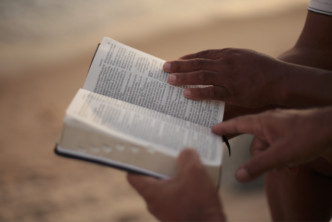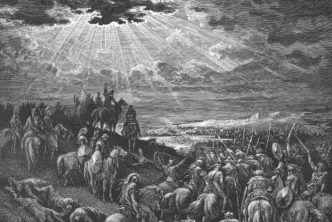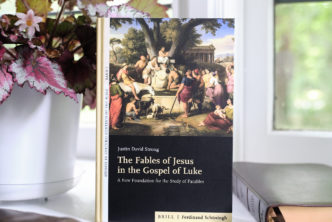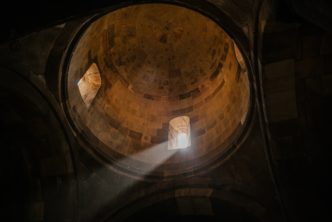
A Priori is a new series on the theLAB in which we put three simple questions to scholars undertaking important research in biblical studies, theology, ethics, and more. We seek out those authors whose mission is the church, whose vocation is research. This week we hear from Andrew Hollingsworth and his work on semiotics and theology.
1. Who are you, where did you study, and what work have you published so far?
My name is Andrew Hollingsworth. I completed my PhD (Systematic Theology) at New Orleans Baptist Theological Seminary, where I wrote my dissertation, “‘Ecos’ in the Labyrinth: Systematic Theology as Semiotic Phenomenon,” wherein I used insights from the semiotic theory of Umberto Eco to develop a semiotic approach to systematic theology. It has since been published as a monograph, God in the Labyrinth: A Semiotic Approach to Christian Theology, with Wipf & Stock Publishers. I also have written three articles, amongst others, bringing insights from semiotic theory to bear on matters of theology: “Ecos of Meaning: Umberto Eco’s Semiotic Theory for Theological Hermeneutics” (Global Journal of Classical Theology 15.1; “Wolfhart Pannenberg’s Semiotic Doctrine of the Church: A Peircean Corrective” (Neue Zeitschrift für Systematische Theologie und Religionsphilosophie (In Press)); and “Charles Sanders Peirce, Semiotics, and the Imago Dei” (Churchman (In Press)).
2. What research/writing project are you currently working on that you are most excited about? Have you presented papers related to this topic, and can you give us a little taster from your writing?
Currently, I am working on what will be my third book, Semiotics: An Introduction for Theologians. I discovered the need for this book while researching my dissertation, whence I realized that there were not even a handful of monographs or other books bringing theology into conversation with semiotics. Sure, multiple biblical scholars have dialogued with semiotic theory in developing theories of intertextuality and textual hermeneutics. However, systematic theologians have engaged very little with semiotic theory, which has ample opportunity to provide robust contributions to theological method, especially theories of God-talk and theological epistemology. This is especially the case with the semiotic theories of Charles Sanders Peirce and John Deely, both of whom receive ample attention in this book.
I presented some of the material in this book in my paper “Towards a Theological Pragmaticism: Retrieving Charles Sanders Peirce for Theological Method” at Annual Meeting of the Evangelical Theological Society in Denver (2018), and in my paper “Whither and Why Semiotics: A Call for Christian Philosophers and Theologians to Engage the Doctrine of Signs,” which was accepted for presentation at the Southwest Regional Meeting of the Evangelical Philosophical Society in Dallas (2020), though the COVID-19 pandemic resulted in the cancellation of the conference. I have re-worked this paper and proposed for the 2020 Annual Meeting of the Evangelical Theological Society in Providence. I am awaiting the decision on the proposal.
Here is a brief exert from my forthcoming semiotics introduction:
Whether one is a semiotician, a code-breaker, a mathematician, an architect, a painter, a writer, a philosopher, a scientist, a barista, a pastor, a waiter, or a theologian, they are always caught up in the never-ending play of signs.1 If someone ever wanted to escape signs, to live their life apart from them, they would be highly disappointed. Indeed, they would never be able to experience the world around us were it not for signs. I know, this seems a bit extreme; nonetheless, it is true. Signs are what make experience of the world possible, and there is no experience of the world that does not involve some interplay of signs. This was an insight put forth by Charles Sanders Peirce, one of the fathers of modern semiotics. For Peirce, all of reality was perfused with signs, if it was not entirely made up of them. If all of reality is perfused with, or made up of, signs, then there is no form of academic discipline or reflection that is not concerned with signs to some extent or another, including the discipline of theology. . . .
As I have met other theologians and philosophers at conferences and discussed my work with them, I have learned that many are simply unaware about the field of semiotics. Many are unaware that semiotics is not just another way of talking about language, but that it extends to cover many disciplines and areas that involve signification, such as biosemiotics, zoosemiotics, and the relationship between semiotics and the philosophy of mind. I do not blame them for this, as there has never been a text introducing the world of semiotics tailored to them. Thus, the aim of this book is to provide an introduction to semiotics for theologians, one that highlights the usefulness and importance that semiotics has for theology.
3. Which readers is the final product intended for, and when do you anticipate we might see the fruit of your research in published form?
This book is aimed at both undergraduate and graduate students of theology and philosophy of religion. It would also serve professional scholars and theologians who have no background or familiarity with semiotics. My goal is to have a contract for this book this summer (2020), wherein I would contract to submit the final manuscript Summer 2021. It hopefully would then be on the shelf by November 2021.
Tell us about your research here on theLAB. Send an email to tavis.bohlinger@faithlife.com answering the three questions above. Contributions are published in the order they are received. We look forward to highlighting your work!




[…] “A Semiotic Theory of Theology and Philosophy” deals with the concept of nature from an unusually broad perspective, viewing nature as encompassing every …Semiotic theory theology and philosophy | Theology …www.cambridge.org › …The concern of this work is with developing an alternative to standard categories in theology and philosophy, especially in terms of how they deal with nature.Incarnation and Semiotics: A Theological and Anthropological …www.tandfonline.com › … › Volume 8, Issue 3Aug 25, 2010 — We have offered, then, a semiotic account of religious transformation according to which such transformation occurs when signs are interpreted …by A Robinson · 2010 · Cited by 4 · Related articlesA semiotic perspective on… · The semiotic matrix and… · The semiotic matrix as a…Peirce’s Theological Semiotic – The University of Chicago …www.journals.uchicago.edu › doi › pdfplusPeirce’s Theological Semiotic*. M ichael L. Raposa / Lehigh University. Charles Peirce described his essay, “A Neglected Argument for The. Reality of God,” as …by ML Raposa · 1987 · Cited by 7 · Related articlesa priori: Andrew Hollingsworth’s Research on Semiotics and …academic.logos.com › … […]